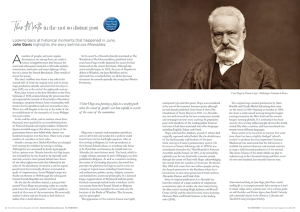Looking back at historical moments that happened in June, John Davis highlights the story behind Les Miserables.

A number of people, and some regular theatregoers are among them, are under a serious misapprehension that because the novel and subsequent musical Les Miserables includes insurrection, barricades and street fighting in Paris that it is about the French Revolution. They would of course be wrong.
The brief rebellion that forms a key role in the second half of both the original story and its iconic stage production actually occurred over two days in June 1832, not at the end of the eighteenth century.
Riots, later known as the June Rebellion or the Paris Uprising of 1832, erupted during the procession that accompanied the funeral of General Jean Maximilien Lemarque, a popular former Army commander, well known for his republican and anti-monarchist views. There was still disquiet in the city in the wake of the re-establishment of the monarchy of Louis Philippe two years earlier.
In the end the rebels, said to number about three thousand, were quashed by an overwhelming force of National Guards and regular soldiers. Estimated figures recorded suggest that about seventy of the government forces were killed while almost one hundred insurgents lost their lives. There were a large number of casualties on both sides.
Initially a young artist, Michel Geoffroy was charged with starting the rebellion by waving a red flag. Although he was sentenced to death, legal appeals led to a prison term. Months later the real flag-bearer was revealed but he was found to be mentally unfit and only served a short period behind bars. Seven of the other eighty-two trials that followed in the wake of the disturbance resulted in a call for capital punishment but eventually all were commuted to spells of imprisonment. Louis Philippe’s reign was finally overthrown in 1848 though the subsequent Second French Republic was short-lived.
On the day the rebellion started, a young writer named Victor Hugo was penning a play in a nearby park when the sound of gunfire sent him rapidly in search of the cause of the commotion. He eventually tracked it down and was forced to find shelter as bullets flew in both directions.
In his novel Les Miserables (literally translated as The Wretched or The Downtrodden), published thirty years later, Hugo vividly depicted the scenes he had witnessed on the streets first-hand. Although the novel actually begins in 1815, the year of Napoleon’s defeat at Waterloo, the June Rebellion and its aftermath has a marked effect on all the fictitious characters he created especially the young hero Marius Pontmercy.
Hugo was a staunch and outspoken republican activist all his life and would, for a spell, be exiled from France for his forthright opinions. After at first settling in Belgium, he took up residence in the Channel Islands where, in a harbour-side house at St. Peter Port on Guernsey, he would write Les Miserables, his most famous work. The book, which in a single volume, amounts to over 1300 pages, was first published in Belgium. As well as a narrative involving the stories of the leading characters, the novel also provides the platform for Hugo to air his views on a range of topical issues including French history and architecture, politics, justice, religion, romantic and familial love and moral philosophy. It is believed Hugo stepped ashore at Weymouth with his partly finished manuscript tucked inside a briefcase on his sea journey from the Channel Islands to Belgium where he wanted to complete his research into the location of the Battle of Waterloo. This, however, may be apocryphal.
The appearance of the novel in France was highly anticipated. Up until that point, Hugo was considered to be one of his country’s foremost poets although he had already published Notre-Dame de Paris (The Hunchback of Notre Dame) in 1831. Les Miserables was not well received by his own countrymen initially and newspaper reviews were scathing. Its popularity grew with members of the reading public however and soon it had been translated into other languages including English, Italian and Greek.
Hugo, who had five children, several of whom died tragically, espoused radical beliefs like the abolishment of the death penalty and freedom of the press while serving in France’s parliamentary system. On his return to France following exile in 1870 he was immediately elected to the Third Republic’s National Assembly and the Senate. In 1881, as he entered his eightieth year, he was feted with a massive parade through the centre of Paris with Hugo acknowledging the crowds from the window of his house. He died in May 1885 with more than two million people joining the funeral procession to the Pantheon where he is buried close to two other prominent French authors, Alexandre Dumas and Emile Zola.
Since its original publication, Les Miserables has been the subject of a large number of adaptations in numerous types of media, the most recent being the film version starring Hugh Jackman and Russell Crowe (2012) and the television mini-series featuring Dominic West and David Oyelowo in the leading roles (2018).
The original stage musical production by Alain Boublil and Claude-Michel Schonberg first came on the scene in 1980. Opening in London in 1985, the show is multi-award winning being the longest running musical in the West End and the second longest running globally. It is estimated it has been seen by over seventy million people all over the world, visited fifty-three countries and been translated into twenty-seven different languages.
There seems to be no end to its success. For some time, there has been a slightly abridged ‘school’s version’ to perform but now impresario Cameron Mackintosh has sanctioned that the full version is available for amateur dramatic and musical societies to stage a fully licensed production of the musical. The arena version of the show, which can play to audiences up to five thousand strong and have a cast of over one hundred, has recently been on tour.



